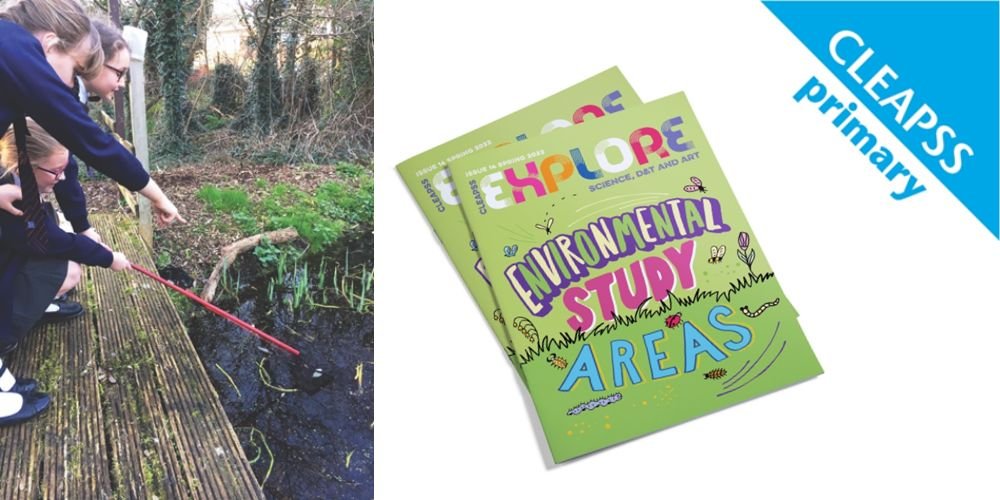At CLEAPSS our goal is to deliver advice that supports you and your children to carry out safe exciting practical work. We make safety guidance easy to access, understand and implement.
Where can I find this guidance?
You can access our resources in 3 ways:
EXPLORE magazine: published termly, sent to all member schools and available via our website, EXPLORE provides up to date safety guidance, lots of practical teaching ideas, advice, articles by guest writers and much more. For example, the latest issue ‘EXPLORE#14’ is designed to help support your children learn about their local environment and what they can do to improve and preserve it.
CLEAPSS Primary website: www.cleapss.org.uk contains specially designed information including practical teaching ideas, how to do things safely and leadership guidance. If you need a practical teaching idea that you know has been trialled in schools, is cost effective and has all the safety built in, either type activity specific key words in to the search tool or browse our Teaching ideas section.
If you are a science leader and want to deliver some quick, easy and engaging H&S training for colleagues search - ‘Are we allowed to’ for a 10 minute quiz using questions and myths staff often have about safety in common practical activities.
Helpline: if your school is a member of CLEAPSS you can contact the CLEAPSS helpline and get advice on almost anything to do with science, technology or art by emailing us at primary@cleapss.org.uk or by calling 01895 251496.
How do I know if I am a member?
The good news is it is highly likely your employer is already paying your membership. To find out, contact the CLEAPSS Helpline: primary@cleapss.org.uk .
For further details about the benefits of membership and the ways in which we enable headteachers, governors and trustees to meet their statutory responsibilities with regard to health and safety, search - ‘membership’ on the CLEAPSS Primary website and look at ‘CLEAPSS primary information leaflet’ and ‘Reasons for primary schools to belong to CLEAPSS’.
If you are a member but don’t know your password, contact the CLEAPSS Helpline: primary@cleapss.org.uk .
Assessing the risks of your Great Science Share for Schools (GSSfS) activity
Excited children seeing new science activities; the awe, the exhilaration, what could be better? BUT, in the eagerness of planning, don’t forget that the children visiting your children’s stand won’t be from your class and you won’t know them in the same way that you do your own children.
To keep everyone safe you will have to have thought about your risk assessments. Below are some tips to help you do this if you and your children are attending or hosting a GSSfS event, or simply doing science as part of a Great Science Share your school:
· Look at the CLEAPSS primary website www.cleapss.org.uk for activity ideas and advice on doing things safely.
· CLEAPSS advice is designed for use in a classroom with children, not for public events. You need to make this advice your starting point and adjust it to fit the activity or event context, in some cases that may be a classroom or busy hall with lots of excited children. If the space is very different to a classroom CLEAPSS safety advice may not be enough. You may need to add to or strengthen it.
· Only do activities that you would do in your own classroom and school. The risk assessments for those will be a good place to start.
· Think about the age range of the children involved and those visiting; choose activities that all children can safely participate in.
· Make sure any child demonstrators know about any hazards associated with their activity and can communicate how to stay safe to visiting children (simple signage may help).
· GSSfS activities are engaging and events are busy and exciting so avoid activities where children need lots of space to work.
· With the best will in the world you won’t always be able to provide close supervision. Choose activities that require low levels of supervision or adjust the way you showcase the activity.
Risk assessment is a process:
· Think about the activity,
· find out what the risks and safety measures needed are, (CLEAPSS resources can help you do this),
· if needed, add to or strengthen any safety measures to account for the setting and the diversity of the children that will be undertaking the activity,
· record any safety measures in a way that helps you and your demonstrators to carry them out,
· stick to your plan, beware of making changes on the fly that you have not had time to think through.
For example:
Your children might run an activity that includes using chopped fruits/vegetables. In your classroom, with your children, you might let them chop the fruit. But at the event it would be better to have the items chopped in advance. This will remove the risk of children you don’t know using knives at a confined and busy table.
Hopefully your children will be mobbed with enthusiastic visitors to their table. But what would happen if they run out of pre-cut fruit/vegetables? Do you give them some chopping boards and knives? No, go back to the safety measure you originally implemented i.e. have a plan for how you’ll safely prepare more fruit/veg away from the stand or call it a day and let your children experience the other great activities happening in the space.
In our example you would need to explain to your children that the fruits/vegetables are for the experiment and must not be eaten. Putting a sign up, on the day, saying “Please don’t eat the fruit” will help enforce this simple safety message.
For more details of our simple risk assessment process, search - ‘How to do a risk assessment’ on the CLEAPSS Primary website or search - ‘Explore’ and look at pgs4-5 of Explore#05, or look in the leadership area of the website for the snappily titled - ‘The really short and pain free guide to health and safety’; a 10 minute presentation that explains how to do a risk assessment. For more information about running an activity outside of a classroom, search – ‘GSSfS’.
Household materials are often used during primary science activities. Many are perfectly safe, and their imaginative use can encourage a real enthusiasm and understanding of STEAM subjects.
But just because a material is a household product, doesn’t automatically mean it is safe. Search –‘EXPLORE#13 Using household materials’, for newly updated guidance about materials which will help you be sure that you are using materials safely in your classroom or GSSfS activities.
If you need help with your GSSfS risk assessments start by contacting your GSSfS organiser. CLEAPSS are here to make practical work happen, so if you need to contact us use the helpline. If you work in a Scottish school your H&S advisor is SSERC https://www.sserc.org.uk/. Similar to CLEAPSS they’re able to advise you on all matters STEM in Scotland: primary@sserc.scot .





